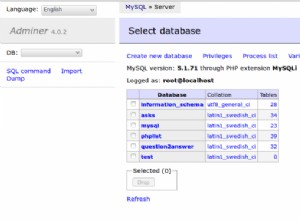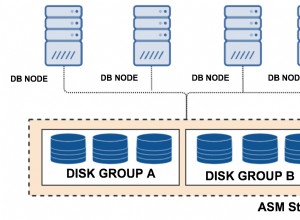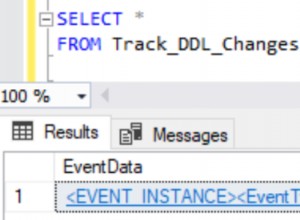Pengantar.
Di sini, kita akan membangun Modul Kelas untuk tugas pemrosesan data, sebuah DAO.Recordset Objek akan diteruskan ke Objek Kelas Kustom. Karena ini adalah Objek yang diteruskan ke Kelas Kustom kami, kami memerlukan Set dan Dapatkan Pasangan Prosedur Properti untuk menetapkan dan mengambil Objek atau nilai Propertinya.
Kami memiliki Tabel kecil:Tabel1 , dengan sedikit catatan di dalamnya. Berikut adalah gambar Tabel1.

Tabel di atas hanya memiliki empat bidang:Desc, Qty, UnitPrice, dan TotalPrice. Kolom TotalPrice kosong.
- Salah satu tugas Modul Kelas kami adalah memperbarui bidang TotalPrice dengan produk Qty * UnitPrice.
- Modul Kelas memiliki subrutin untuk mengurutkan data, di bidang yang ditentukan pengguna, dan membuang daftar di Jendela Debug.
- Subrutin lain membuat salinan Tabel dengan nama baru, setelah mengurutkan data berdasarkan nomor kolom yang disediakan sebagai parameter.
Modul Kelas ClsRecUpdate.
- Buka Access Database Anda dan buka Jendela VBA.
- Menyisipkan Modul Kelas.
- Ubah Nama Nilai Propertinya menjadi ClsRecUpdate .
- Salin dan Tempel Kode berikut ke dalam Modul Kelas dan simpan Modul:
Option Compare Database Option Explicit Private rstB As DAO.Recordset Public Property Get REC() As DAO.Recordset Set REC = rstB End Property Public Property Set REC(ByRef oNewValue As DAO.Recordset) If Not oNewValue Is Nothing Then Set rstB = oNewValue End If End Property Public Sub Update(ByVal Source1Col As Integer, ByVal Source2Col As Integer, ByVal updtcol As Integer) 'Updates a Column with the product of two other columns Dim col As Integer col = rstB.Fields.Count 'Validate Column Parameters If Source1Col > col Or Source2Col > col Or updtcol > col Then MsgBox "One or more Column Number(s) out of bound!", vbExclamation, "Update()" Exit Sub End If 'Update Field On Error GoTo Update_Err rstB.MoveFirst Do While Not rstB.EOF rstB.Edit With rstB .Fields(updtcol).Value = .Fields(Source1Col).Value * .Fields(Source2Col).Value .Update .MoveNext End With Loop Update_Exit: rstB.MoveFirst Exit Sub Update_Err: MsgBox Err & " : " & Err.Description, vbExclamation, "Update()" Resume Update_Exit End Sub Public Sub DataSort(ByVal intCol As Integer) Dim cols As Long, colType Dim colnames() As String Dim k As Long, colmLimit As Integer Dim strTable As String, strSortCol As String Dim strSQL As String Dim db As Database, rst2 As DAO.Recordset On Error GoTo DataSort_Err cols = rstB.Fields.Count - 1 strTable = rstB.Name strSortCol = rstB.Fields(intCol).Name 'Validate Sort Column Data Type colType = rstB.Fields(intCol).Type Select Case colType Case 3 To 7, 10 strSQL = "SELECT " & strTable & ".* FROM " & strTable & " ORDER BY " & strTable & ".[" & strSortCol & "];" Debug.Print "Sorted on " & rstB.Fields(intCol).Name & " Ascending Order" Case Else strSQL = "SELECT " & strTable & ".* FROM " & strTable & ";" Debug.Print "// SORT: COLUMN: <<" & strSortCol & " Data Type Invalid>> Valid Type: String,Number & Currency //" Debug.Print "Data Output in Unsorted Order" End Select Set db = CurrentDb Set rst2 = db.OpenRecordset(strSQL) ReDim colnames(0 To cols) As String 'Save Field Names in Array to Print Heading For k = 0 To cols colnames(k) = rst2.Fields(k).Name Next 'Print Section Debug.Print String(52, "-") 'Print Column Names as heading If cols > 4 Then colmLimit = 4 Else colmLimit = cols End If For k = 0 To colmLimit Debug.Print colnames(k), Next: Debug.Print Debug.Print String(52, "-") 'Print records in Debug window rst2.MoveFirst Do While Not rst2.EOF For k = 0 To colmLimit 'Listing limited to 5 columns only Debug.Print rst2.Fields(k), Next k: Debug.Print rst2.MoveNext Loop rst2.Close Set rst2 = Nothing Set db = Nothing DataSort_Exit: Exit Sub DataSort_Err: MsgBox Err & " : " & Err.Description, vbExclamation, "DataSort()" Resume DataSort_Exit End Sub Public Sub TblCreate(Optional SortCol As Integer = 0) Dim dba As DAO.Database, tmp() As Variant Dim tbldef As DAO.TableDef Dim fld As DAO.Field, idx As DAO.Index Dim rst2 As DAO.Recordset, i As Integer, fldcount As Integer Dim strTable As String, rows As Long, cols As Long On Error Resume Next strTable = rstB.Name & "_2" Set dba = CurrentDb On Error Resume Next TryAgain: Set rst2 = dba.OpenRecordset(strTable) If Err > 0 Then Set tbldef = dba.CreateTableDef(strTable) Resume Continue Else rst2.Close dba.TableDefs.Delete strTable dba.TableDefs.Refresh GoTo TryAgain End If Continue: On Error GoTo TblCreate_Err fldcount = rstB.Fields.Count - 1 ReDim tmp(0 To fldcount, 0 To 1) As Variant 'Save Source File Field Names and Data Type For i = 0 To fldcount tmp(i, 0) = rstB.Fields(i).Name: tmp(i, 1) = rstB.Fields(i).Type Next 'Create Fields and Index for new table For i = 0 To fldcount tbldef.Fields.Append tbldef.CreateField(tmp(i, 0), tmp(i, 1)) Next 'Create index to sort data Set idx = tbldef.CreateIndex("NewIndex") With idx .Fields.Append .CreateField(tmp(SortCol, 0)) End With 'Add Tabledef and index to database tbldef.Indexes.Append idx dba.TableDefs.Append tbldef dba.TableDefs.Refresh 'Add records to the new table Set rst2 = dba.OpenRecordset(strTable, dbOpenTable) rstB.MoveFirst 'reset to the first record Do While Not rstB.EOF rst2.AddNew 'create record in new table For i = 0 To fldcount rst2.Fields(i).Value = rstB.Fields(i).Value Next rst2.Update rstB.MoveNext 'move to next record Loop rstB.MoveFirst 'reset record pointer to the first record rst2.Close Set rst2 = Nothing Set tbldef = Nothing Set dba = Nothing MsgBox "Sorted Data Saved in " & strTable TblCreate_Exit: Exit Sub TblCreate_Err: MsgBox Err & " : " & Err.Description, vbExclamation, "TblCreate()" Resume TblCreate_Exit End Sub
Properti rstB dideklarasikan sebagai Objek DAO.Recordset.
Melalui Prosedur Set Properti, objek recordset dapat diteruskan ke Kelas ClsRecUpdate Objek.
Pembaruan() Subrutin menerima nomor tiga kolom (nomor kolom berdasarkan 0) sebagai parameter untuk menghitung dan memperbarui kolom parameter ketiga dengan produk dari kolom pertama * kolom kedua.
DataSort() subrutin Mengurutkan record dalam urutan menaik berdasarkan Nomor Kolom yang diteruskan sebagai parameter.
Tipe data Sorting Column harus Number atau Currency atau String. Tipe data lainnya diabaikan.
Daftar catatan akan dibuang di Jendela Debug. Daftar kolom akan dibatasi hingga lima kolom saja, jika sumber rekaman memiliki lebih dari itu, maka kolom lainnya akan diabaikan.
TblCreate() subrutin akan Mengurutkan data, berdasarkan nomor kolom yang dilewatkan sebagai parameter, dan membuat Tabel dengan nama baru. Parameter adalah opsional, jika nomor kolom tidak dilewatkan sebagai parameter maka Tabel akan diurutkan pada data di kolom pertama jika tipe data kolom adalah tipe yang valid. Nama asli Tabel akan diubah dan ditambahkan dengan String “_2” ke nama aslinya. Jika nama Tabel Sumber adalah Tabel1 maka nama tabel baru akan menjadi Table1_2 .
Program Tes untuk ClsUpdate.
Mari kita uji ClsRecUpdate Kelas Objek dengan Program kecil.
Kode program pengujian diberikan di bawah ini:
Public Sub DataProcess()
Dim db As DAO.Database
Dim rstA As DAO.Recordset
Dim R_Set As ClsRecUpdate
Set R_Set = New ClsRecUpdate
Set db = CurrentDb
Set rstA = db.OpenRecordset("Table1", dbOpenTable)
'send Recordset Object to Class Object
Set R_Set.REC = rstA
'Update Total Price Field
Call R_Set.Update(1, 2, 3) 'col3=col1 * col2
'Sort Ascending Order on UnitPrice column & Print in Debug Window
Call R_Set.DataSort(2)
'Create New Table Sorted on UnitPrice in Ascending Order
Call R_Set.TblCreate(2)
Set rstA = Nothing
Set db = Nothing
xyz:
End Sub Anda dapat melewati recordset apa pun untuk menguji Objek Kelas.
Anda dapat memberikan nomor kolom apa pun untuk memperbarui kolom tertentu. Nomor kolom tidak harus nomor berurutan. Tapi, parameter nomor kolom ketiga adalah kolom target untuk diperbarui. Parameter pertama dikalikan dengan parameter kolom kedua untuk sampai pada nilai hasil yang akan diperbarui. Anda dapat memodifikasi kode Modul Kelas untuk melakukan operasi lain yang ingin Anda lakukan pada tabel.
Pemilihan tipe data Sortir Kolom harus String, Numerik, atau Tipe Mata Uang saja. Jenis lain diabaikan. Nomor kolom Recordset berbasis 0, yang berarti nomor kolom pertama adalah 0, kolom kedua adalah 1, dan seterusnya.
Daftar Semua Tautan pada Topik ini.
- Modul Kelas MS-Access dan VBA
- Array Objek Kelas VBA MS-Access
- Kelas Dasar MS-Access dan Objek Turunannya
- Kelas Dasar VBA dan Objek Turunan-2
- Varian Kelas Dasar dan Objek Turunan
- Set Rekaman Ms-Access dan Modul Kelas
- Mengakses Modul Kelas dan Kelas Pembungkus
- Transformasi Fungsionalitas Kelas Wrapper
- Dasar-dasar Ms-Access dan Objek Koleksi
- Modul Kelas Ms-Access dan Objek Koleksi
- Rekaman Tabel dalam Objek dan Formulir Koleksi
- Dasar-dasar Objek Kamus
- Dasar-Dasar Objek Kamus-2
- Mengurutkan Kunci Objek dan Item Kamus
- Menampilkan Rekaman dari Kamus ke Formulir
- Menambahkan Objek Kelas sebagai Item Kamus
- Memperbarui Item Kamus Objek Kelas pada Formulir




